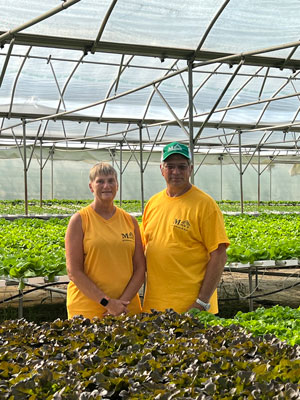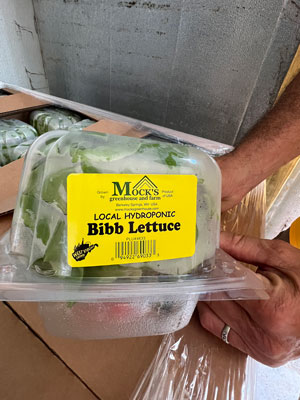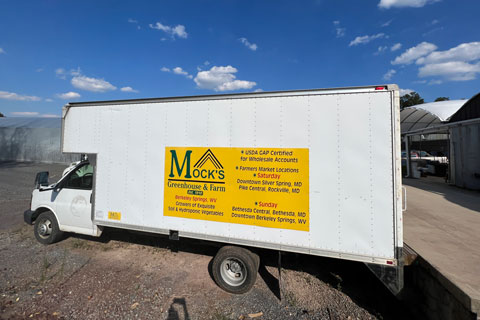11/1/2023
Homegrown Hydroponics
Jennifer Polanz

Not every controlled environment agriculture story starts with a round of investors and a multi-million-dollar glasshouse or building constructed. Sometimes it starts with a wedding, a CropKing seminar, a couple of poly greenhouses and a concept for growth.
That’s the gist of the story behind Paul and Raynette Mock’s beginnings at Mock’s Greenhouse in Berkeley Springs, West Virginia, now the second-largest hydroponic growing operation in the state. Paul reached out to me after reading about the turmoil in the CEA industry related to growers expanding fast and then closing their doors.
Pictured: Paul and Raynette Mock have been growing hydroponic products for 17 years at their Berkeley Springs, West Virginia, location.
While there’s room for big-dollar investment operations, he wanted to make the point there’s also room for smaller operations that supply everything from farmers markets, restaurants and wholesale food distributors, as well as grocery.
“Every city has a private owner of a coffee shop, still to this day. They’re not going to serve 10 states, but they’re just as important to the community,” he said on the phone, comparing large growers to his 2-acre, multi-greenhouse facility. “That’s how I feel where we’re at right now. The large corporation is fine, but we don’t want to forget about people of my size, or the ones that are a little bigger or smaller.”
After hearing a little about their story, I hopped in the car and headed from Northeast Ohio through most of Pennsylvania, spent a hot second in Maryland traversing the Potomac River, and crossed into the foothills of West Virginia to check it out.
Beginning the journey
Paul Mock is no stranger to growing plants (or Raynette for that matter, a long-time gardener who also worked at a medical center). His father had a bedding plant and field vegetable growing operation that Paul took over in the mid-1980s in Windber, Pennsylvania. After the bedding plant season was finished, he actually dabbled in hydroponic tomato growing, but didn’t have the dedicated equipment to really make it work.
“I said to myself, if I ever do hydroponics again, the houses are going to be devoted just to hydroponics,” Paul said, and Raynette added: “And they’re going to be true hydroponic houses!”
His and Raynette’s marriage is the second for both and Raynette already had the 33-acre property in the hills in Berkeley Springs. In fact, she designed the house—she has an associate degree in architecture—that sits on the property. It’s an unusual setup for a growing operation, as it’s at the top of a rather steep hill with a dirt road feeding into the main road (a situation that due to local regulations cannot be changed). When Paul moved there, they had to rule out some of the agri-tainment options he had at the Windber location (farm tours for kids, fall festivals and Christmas trees). He did some landscape work, Raynette continued to work at the medical center and they both considered hydroponic growing as an option for a year-round diversified operation.
They investigated further by taking a CropKing class on hydroponics in 2004, then purchased a new CropKing greenhouse and two used CropKing poly-covered greenhouses from Iowa, and started amassing equipment in 2005. Their first crops of Bibb lettuce and red greenhouse tomatoes were harvested in 2006. As for customers, if you only considered local options it got dicey, but if you looked at the bigger picture it opened up quite a lot.
“When we started talking about the greenhouses, I said, ‘Well, first off, the whole county only has 16,000 people,’” Paul noted of Morgan County. “We’re never going to make a living selling stuff just in the county. But a little over 100 miles away, there’s 5 million people. And we just need a fraction of 5 million people to make a living in what we want to do.”
Within a half hour, you can be in Pennsylvania, Maryland and Virginia from their little spot of heaven on the hilltop. You can be in the nation’s capital in an hour-and-a-half. While they didn’t have a lot lined up right away, they knew the potential was there. But they also knew they couldn’t expand until they tapped into that potential.

Expanding market share
It was a two-pronged process—understanding what they could grow and getting a handle on what the market wanted. For example, growing Bibb lettuce and tomatoes for Whole Foods.
“It wasn’t like us going from three greenhouses to 30,” Paul said. “We expanded as we developed market share. Like I said, Whole Foods that first year with lettuce and tomatoes. And then we went to them one winter and said, ‘We don’t want to grow you any more tomatoes, I’m sorry. What else can we grow?’ They said: ‘Can you grow us watercress?’”
It took some trial and error, but they found a variety of watercress that worked for both their production and Whole Foods’ needs to replace product coming from California, and now the Mocks have at times up to four greenhouses producing watercress, with Whole Foods buying 70% of it.
Pictured: Bibb lettuce was one of the first crops Mock’s Greenhouse grew and continues to be one of its biggest sellers today. They pack out 94% of what they grow in this deep water culture system. They also grow Bibb in NFT channels in other greenhouses.
Paul and Raynette found out early, too, that growing commodity red greenhouse tomatoes wasn’t going to make them the price they needed to keep the greenhouses going. They started growing heirloom tomatoes, which are notoriously fussy to grow, but also command upwards of $5 a pound, depending on where you sell them. They began to sell at farmers markets and were able to get $4.95 a pound, making the fuss worthwhile.
But even then, they didn’t just sell at any farmers market. As Paul said, not all farmers markets are the same, and at a country market, the prices are going to be less than in the city. They have two trucks, and at one point they were going to 11 farmers markets in Maryland and Virginia. At some, they see upwards of 5,000 people walk through in a four-hour period, which makes it worth the drive and effort (which includes extra staff, tables, scales, mobile payment systems, tents and other equipment). They still do their local farmers market 10 minutes away, but they’ll only see about 600 people through there.
Expanding into the farmers markets also prompted them to look for new crops, as the more popular stands were ones that offered multiple options to shoppers. Now they grow two kinds of cucumbers (Persian and slicing), six kinds of cherry tomatoes, basil, cilantro and bell peppers, along with the mainstays of Bibb lettuce, assorted artisan lettuces, watercress, and heirloom tomatoes.
As they added customers—which also included individual Wegman’s stores, some local restaurants, Coastal Sunbelt distributor and other food distributors—they carefully measured when it was opportune to add more greenhouses. They have 30 separate greenhouses on the property and many have used equipment inside. The gutter systems are different depending on the greenhouse, and cucumbers and tomatoes are grown in containers with soilless media. Today, their crops are split 18% sold at farmers markets and 82% sold at wholesale.
They were also careful about the customers they added. Paul described it like this as an example: “We’ll sometimes get calls from a restaurant on H Street in D.C. ‘We bought your heirloom tomatoes at the farmers market, do you deliver to us?’ Well, sort of.”
I don’t know if you’ve driven the streets of D.C., but they’re busy and sometimes narrow and hard to maneuver. Rather than driving a 26-ft. straight truck through there for a weekly delivery of 40-lbs. of heirloom tomatoes, they direct them to one of their food distributors, where the restaurant can also request additional items from Mock’s if they’d like.
Refining an expanding operation
As the Mock’s added grocery customers early on, and expanded with more greenhouses, their talks with Wegman’s revealed that the company required GAP Certification. Both Paul and Raynette said the requirements with the certification seemed mostly like common sense, but there were small things that they had to change, like installing shatter-proof bulbs in the greenhouse and creating processes for documentation.
“So in 2008 we got everything done and gave it to Wegman’s and they said, ‘Wonderful, now you can do business with us.’ No sooner did we give that to them, and here are a bunch of other food distributors we were dealing with who were sending us emails: As of November 1 you have to be GAP certified or we can’t do business with you.”
 The Wegman’s requirement proved to be fortuitous for the Mock’s, as hardly any other farmers in the area at the time were certified, giving them a competitive edge. Today, they’re certified under GAP Harmonized, which has more guidelines and more paperwork (but, fortunately, isn’t more expensive).
The Wegman’s requirement proved to be fortuitous for the Mock’s, as hardly any other farmers in the area at the time were certified, giving them a competitive edge. Today, they’re certified under GAP Harmonized, which has more guidelines and more paperwork (but, fortunately, isn’t more expensive).
Pictured: This is the farmers market truck that delivers Mock’s Greenhouse products. They also have a 26-ft. refrigerated truck that delivers within 24-hours of harvesting to a Whole Foods warehouse, multiple individual Wegman’s grocery stores, and to Coastal Sunbelt and other food distribution.
There are always ups and downs in the growing process, and Mock’s has certainly had those related to pest issues, nutrient mixes and other challenges related to growing crops. It was a learning curve, too, to go from bedding plants to hydroponic, but by expanding slowly and adding on individual affordable greenhouses, they’ve been able to contain any potential issues to smaller areas.
While I was there, some houses were getting ready to have their poly removed and replaced, while part of the deep water culture lettuce system was cleared for cleaning before a new crop came in. Often, too, different crops have different needs, and the variety of crops there makes having separate greenhouses an easier way to have different crop climates. The other challenge has been the physical property, which requires clearing and leveling with each expansion, making individual greenhouses an easier proposition.
Making a living
Paul and Raynette know there are no investors looking to buy in to their operation—there’s not enough return for that. But they can easily make the case to the bank to cover expansion projects thanks to a solid bank statement and steady profit. Paul added the key is to have a solid understanding of growing plants and a good plan for adding customers and expanding as you gain market share.
“And that’s my point to some of this,” Paul said. “Whether you have a greenhouse or farm, you don’t have to have hundreds and hundreds of acres of farmland, or you don’t have to have 10 acres of greenhouses to make a living.”